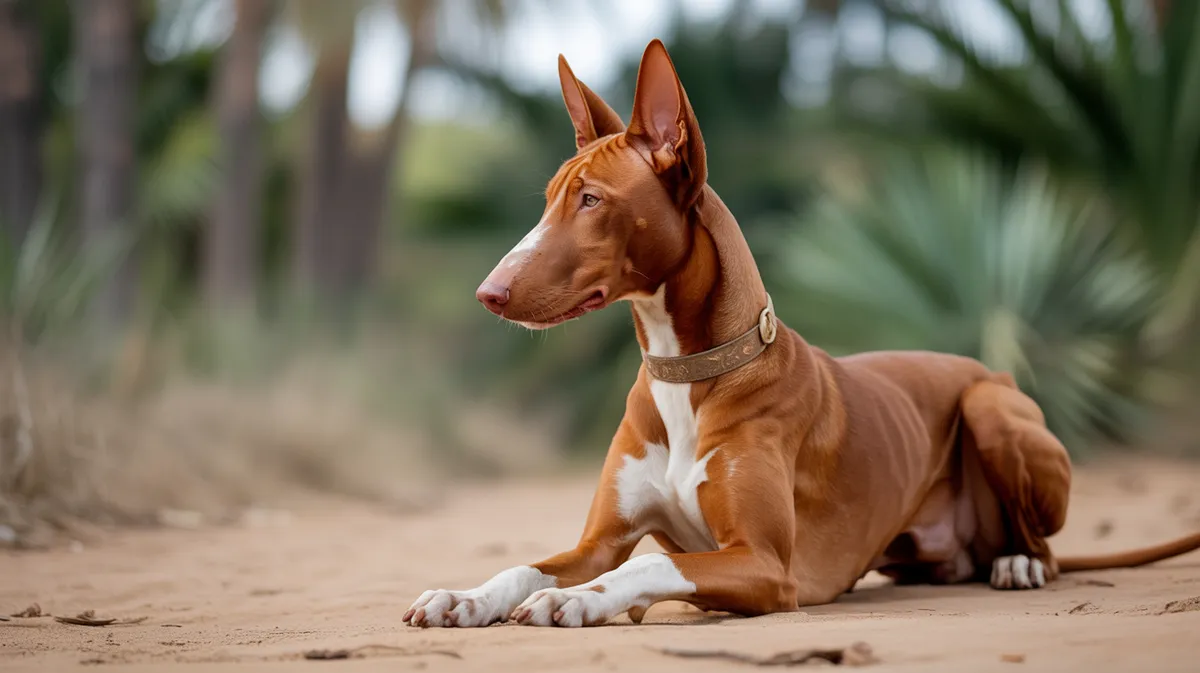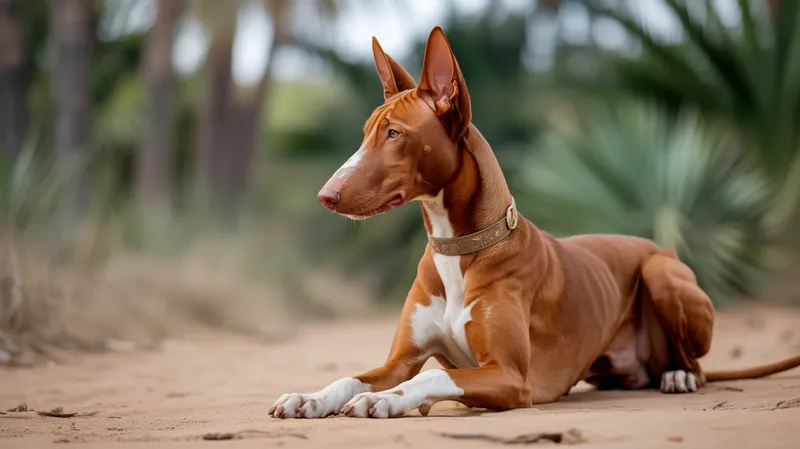
Pharaoh Hound
Canis lupus familiaris

Meet the Pharaoh Hound
The Pharaoh Hound is an elegant and athletic breed, known for its striking appearance and keen hunting instincts. With its slender, graceful body, large erect ears, and amber eyes, this dog is instantly recognizable. Originating from Malta, the breed has been used for thousands of years as a rabbit hunter, prized for its speed and keen sense of smell. Pharaoh Hounds are intelligent, affectionate, and energetic, making them both excellent companions and skilled hunters. Their short, glossy coat and expressive faces add to their unique charm.
Classification
Mammal
Habitat
Domestic; adapted to Mediterranean environments
Diet
Carnivore
Lifespan
11-14 years
Conservation
Least Concern
Weight
18-27 kg
📖Fascinating Facts
Incredible Speed
Pharaoh Hounds are exceptionally fast and agile, capable of sprinting at high speeds to chase small game like rabbits.
Ancient Lineage
The breed's lineage can be traced back over 5,000 years, making it one of the oldest domesticated dog breeds still in existence.
Unique Blushing
Pharaoh Hounds are known for their unique ability to 'blush,' turning their nose and ears a deep pink color when excited.
📋Detailed Description
The Pharaoh Hound (Kelb tal-Fenek) is a medium-sized sighthound with a lean, athletic build, characterized by a deep chest, long legs, and a fine, short coat that ranges in color from tan to rich chestnut. Adult males typically stand 56–64 cm at the withers and weigh 20–25 kg, while females are slightly smaller. The breed is instantly recognizable by its large, erect ears, amber eyes, and a distinctive 'blushing' trait—when excited, the nose and ears flush a rosy pink due to increased blood flow. Pharaoh Hounds possess a flexible, elongated neck and a whip-like tail, both aiding in agility and balance during high-speed pursuits. Their keen eyesight and acute sense of smell make them formidable hunters, especially in the rocky, arid landscapes of Malta. Socially, they are intelligent, affectionate, and form strong bonds with their human families, often displaying playful and gentle behavior. They are highly energetic, requiring regular exercise and mental stimulation. Pharaoh Hounds are known for their clean habits, minimal odor, and low grooming needs, thanks to their short, glossy coat. Despite their hunting heritage, they adapt well to domestic life, provided their exercise needs are met.
💡 Did you know?
Despite their ancient Egyptian look and name, Pharaoh Hounds actually originate from Malta, not Egypt.
🔬Research & Sources
Wikipedia Summary
The Pharaoh Hound or Kelb tal-Fenek is a Maltese breed of hunting dog. It is traditionally used for rabbit-hunting in the rocky terrain of the islands; the Maltese name means "rabbit dog".
Last Modified: 11/8/2024
🎭Behavior & Social Structure
Pharaoh Hounds are primarily crepuscular, being most active at dawn and dusk, which aligns with the activity patterns of their traditional prey, the European rabbit. In hunting, they use a combination of sight, scent, and hearing, working both individually and in small packs. They exhibit a unique hunting strategy called 'stalking and flushing,' where they silently approach prey before making a sudden, explosive chase. Socially, Pharaoh Hounds are pack-oriented, displaying clear hierarchies when kept in groups, but they are also highly people-oriented and thrive on companionship. Their play behavior is marked by bursts of speed and agility, often engaging in chase games. At home, they are alert but not aggressive, making them effective watchdogs without being overly territorial. They communicate through a range of vocalizations, body language, and the aforementioned blushing response. Feeding behavior is typical of domestic dogs, but they retain a strong prey drive and may chase small animals if not properly trained.
👶Reproduction & Life Cycle
Pharaoh Hounds are monoestrous, with females typically coming into heat once or twice per year. The breed does not have a defined breeding season, though in Malta, breeding often coincides with cooler months. Courtship involves ritualized play and mutual grooming. Gestation lasts approximately 63 days, after which litters of 6–8 puppies are common. Neonates are altricial, requiring intensive maternal care, including nursing and thermoregulation. Both parents may participate in socializing the pups, though the dam provides the majority of care. Puppies are weaned at around 6–8 weeks and reach sexual maturity by 10–12 months. Responsible breeders emphasize genetic health screening due to the breed's small gene pool.
🛡️Adaptations & Survival
Pharaoh Hounds are highly adapted for speed and endurance, with a light, aerodynamic body and powerful hindquarters for rapid acceleration. Their large, mobile ears enhance auditory acuity, aiding in prey detection. The breed's short coat provides protection from the Mediterranean heat while minimizing water loss. Their paw pads are thick and resilient, allowing them to traverse rocky, uneven terrain without injury. The breed's unique blushing response may play a role in social signaling. Behaviorally, their intelligence and trainability are adaptations to working closely with humans in cooperative hunting. Their keen senses and high prey drive are evolutionary specializations for hunting small, fast-moving animals in open landscapes.
📚Research Sources
🎨Cultural Significance
The Pharaoh Hound holds a unique place in Maltese culture, where it is celebrated as the national dog and symbol of hunting heritage. The breed's name, Kelb tal-Fenek, reflects its traditional use in rabbit hunting, a practice deeply embedded in rural Maltese life. Although often associated with ancient Egypt due to its resemblance to dogs depicted in pharaonic art, genetic studies indicate the breed developed independently in Malta. The Pharaoh Hound appears on Maltese stamps and coins, and is the subject of local folklore and festivals. Its regal appearance and gentle temperament have made it a popular companion animal and show dog worldwide.
🔬Recent Research & Discoveries
Recent genetic analyses have clarified the breed's origins, dispelling the myth of direct descent from ancient Egyptian dogs and instead supporting a Mediterranean origin with close relations to other regional sighthounds like the Cirneco dell'Etna. Ongoing research focuses on maintaining genetic diversity, mapping hereditary diseases, and understanding the physiological basis of the breed's blushing response. Studies on the breed's hunting behavior have contributed to broader knowledge of sighthound sensory integration and cooperative hunting strategies. The Pharaoh Hound has also been included in comparative studies of canine cognition and social behavior, highlighting its adaptability and intelligence.
🎥Wildlife Videos

Wildlife - Just Wild Dogs | Free Documentary Nature
Wildlife - Episode 7: Just Wild Dogs | Wildlife Documentary Watch 'Wildlife - Episode 8' here: https://youtu.be/kglJpB4ei8o Run ...
Free Documentary - Nature

Pharaoh Hound - Top 10 Facts
The Pharaoh Hound is an ancient dog breed that's changed little since its development more than 5000 years ago. They were the ...
Dogs Wiz

THE AFRICAN WILD DOG: Nature’s Most Ruthless Pack Hunter Unleashed! | Animal Documentary
THE AFRICAN WILD DOG: Nature's Most Ruthless Pack Hunter Unleashed! | Animal Documentary THE AFRICAN WILD DOG: ...
WILD WORLD - Animal Documentary

Wildlife - The Fascinating World of Wild Animals | Full Series | Free Documentary Nature
Wildlife - The Fascinating World of Wild Animals | Wildlife Documentary Watch 'Ocean Stories - Full Series' here: ...
Free Documentary - Nature

3 Hours of The Untold Stories of British Wildlife | Our World
A wildlife documentary series, narrated by Hugh Bonneville, uncovering the hidden lives of animals across diverse habitats ...
Our World

The Baltic | Survival in a Pristine Ecosystem | Animal documentary
Welcome to "The Baltic | Survival in a Pristine Ecosystem", a captivating wildlife documentary that transports you to the serene yet ...
WILD NATURE - Nature animal documentary
🌍Habitat Information
The Pharaoh Hound typically inhabits Domestic; adapted to Mediterranean environments environments. Pharaoh Hounds have adapted to their environments with specialized features and behaviors.
Primary Habitat:
Domestic; adapted to Mediterranean environments
More detailed habitat information will be available soon.
🛡️Conservation Status
The Pharaoh Hound is currently classified as Least Concern. Conservation efforts are crucial for preserving this species for future generations.
Common Threats:
- 🏠Habitat loss and fragmentation
- 🌡️Climate change impacts
- 🎯Hunting and poaching
- 🏭Human-wildlife conflict
⚠️Threats & Conservation Challenges
As a recognized breed, Pharaoh Hounds are not currently at risk in terms of population numbers, and are classified as 'Least Concern.' However, the breed faces challenges related to genetic bottlenecks due to its limited geographic origin and small breeding population. In Malta, habitat loss and changes in traditional hunting practices may impact the breed's cultural role. Globally, irresponsible breeding and loss of genetic diversity are concerns. The breed is generally robust, but can be sensitive to cold and prone to minor health issues such as hip dysplasia and patellar luxation. There are no significant wild populations, so conservation focuses on maintaining breed standards and genetic health.
🔬Scientific Classification
Scientific Name
Canis lupus familiaris
Classification Hierarchy
🔍 About Taxonomic Classification
Taxonomic classification is a hierarchical system used by scientists to classify and organize living organisms based on shared characteristics and evolutionary relationships.
The system moves from broad categories (Kingdom) to increasingly specific ones, with each animal's scientific name typically consisting of its Genus and species.
📝Community Notes
Share your observations and insights about the Pharaoh Hound with our community of wildlife enthusiasts.
Join Our Community
Sign in to share your observations and connect with fellow wildlife enthusiasts.
Sign In to ContributeNo community notes yet
Be the first to share your observations about the Pharaoh Hound!
Explore Pharaoh Hound
Select a tab above to learn more about this amazing animal.
📸Photo Gallery
No photos available for this animal yet.
🌟Discover More Wildlife
Continue your journey of discovery with more fascinating animals from our database
